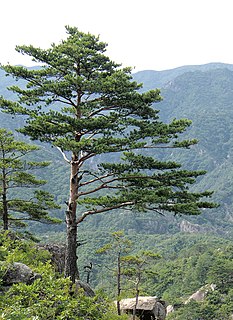
A pine is any conifer in the genus Pinus of the family Pinaceae. Pinus is the sole genus in the subfamily Pinoideae. The Plant List compiled by the Royal Botanic Gardens, Kew and Missouri Botanical Garden accepts 126 species names of pines as current, together with 35 unresolved species and many more synonyms. Pine may also refer to the lumber derived from pine trees; pine is one of the more extensively used types of wood used as lumber.

The Douglas fir is an evergreen conifer species in the pine family, Pinaceae. It is native to western North America and is also known as Douglas-fir, Douglas spruce, Oregon pine, and Columbian pine. There are three varieties: coast Douglas-fir, Rocky Mountain Douglas-fir and Mexican Douglas fir.

Pine Bluff is the tenth-largest city in the state of Arkansas and the county seat of Jefferson County. It is the principal city of the Pine Bluff Metropolitan Statistical Area and part of the Little Rock-North Little Rock-Pine Bluff Combined Statistical Area. The population of the city was 49,083 in the 2010 Census with 2019 estimates showing a decline to 41,474.
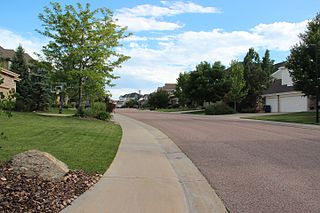
The City of Castle Pines is a Home Rule Municipality located in Douglas County, Colorado, United States. Castle Pines is a part of the Denver–Aurora–Lakewood, CO Metropolitan Statistical Area. As of the 2010 census, the population of the city was 10,360. By 2019, the United States Census Bureau estimated the population to have increased to 10,763. The city is situated 19 miles (31 km) south-southeast of the Colorado State Capitol in Denver. The city is located north of the Town of Castle Rock and south of the City of Lone Tree, Colorado.
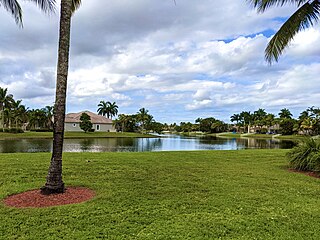
Pembroke Pines is a city in southern Broward County, Florida, United States. The city is located 22 miles north of Miami. The population of Pembroke Pines is estimated at 173,591 as of 2019. It had a population of 154,750 as of the 2010 census, making it the second-most populous city in Broward County after Fort Lauderdale, and the 11th-most populous in Florida. It is a principal city of the Miami metropolitan area, which was home to an estimated 6,012,331 people in 2015.

Turpentine is a fluid obtained by the distillation of resin harvested from living trees, mainly pines. Mainly used as a specialized solvent, it is also a source of material for organic syntheses.

Pinus sylvestris, Scots pine (UK), Scotch pine (US), European red pine, or Baltic pine is a species of tree in the pine family Pinaceae that is native to Eurasia, ranging from Western Europe to Eastern Siberia, south to the Caucasus Mountains and Anatolia, and north to well inside the Arctic Circle in Fennoscandia. In the north of its range, it occurs from sea level to 1,000 m (3,300 ft), while in the south of its range it is a mountain tree, growing at 1,200–2,600 m (3,900–8,500 ft) altitude. It is readily identified by its combination of fairly short, blue-green leaves and orange-red bark.

In the Southern New Jersey and Philadelphia folklore of the United States, the Jersey Devil is a legendary creature said to inhabit the Pine Barrens of South Jersey. The creature is often described as a flying biped with hooves, but there are many variations. The common description is that of a bipedal kangaroo-like or wyvern-like creature with a horse- or goat-like head, leathery bat-like wings, horns, small arms with clawed hands, legs with cloven hooves, and a forked tail. It has been reported to move quickly and is often described as emitting a high-pitched "blood-curdling scream".
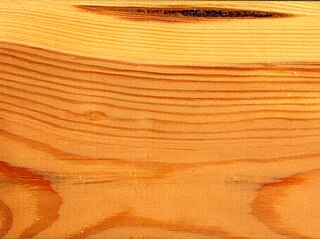
Softwood is wood from gymnosperm trees such as conifers. The term is opposed to hardwood, which is the wood from angiosperm trees.
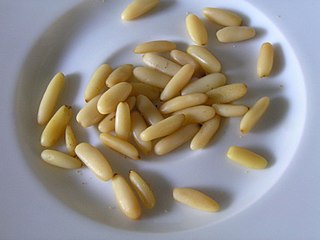
Pine nuts, also called piñón, pinoli, or pignoli, are the edible seeds of pines. According to the Food and Agriculture Organization, only 29 species provide edible nuts, while 20 are traded locally or internationally owing to their seed size are large enough to be worth harvesting; in other pines, the seeds are also edible, but are too small to be of notable value as a human food.

Pinus strobus, commonly denominated the eastern white pine, northern white pine, white pine, Weymouth pine (British), and soft pine is a large pine native to eastern North America. It occurs from Newfoundland, Canada west through the Great Lakes region to southeastern Manitoba and Minnesota, United States, and south along the Appalachian Mountains and upper Piedmont to northernmost Georgia and perhaps very rarely in some of the higher elevations in northeastern Alabama. It is considered rare in Indiana.

Pinus ponderosa, commonly known as the ponderosa pine, bull pine, blackjack pine, western yellow-pine, or filipinus pine is a very large pine tree species of variable habitat native to mountainous regions of western North America. It is the most widely distributed pine species in North America.

The European pine marten, also known as the pine marten or the European marten, is a mustelid native to and widespread in Northern Europe. It is classified as Least Concern on the IUCN Red List. It is less commonly also known as baum marten, or sweet marten.

The New Jersey Pine Barrens, also known as the Pinelands or simply the Pines, is the largest remaining example of the Atlantic coastal pine barrens ecosystem, stretching across more than seven counties of New Jersey. Two other large, contiguous examples of this ecosystem remain: the Long Island Central Pine Barrens, and the Massachusetts Coastal Pine Barrens. The name pine barrens refers to the area's sandy, acidic, nutrient-poor soil. Although European settlers could not cultivate their familiar crops there, the unique ecology of the Pine Barrens supports a diverse spectrum of plant life, including orchids and carnivorous plants. The area is also notable for its populations of rare pygmy pitch pines and other plant species that depend on the frequent fires of the Pine Barrens to reproduce. The sand that composes much of the area's soil is referred to by the locals as sugar sand.

A conifer cone is an organ on plants in the division Pinophyta (conifers) that contains the reproductive structures. The familiar woody cone is the female cone, which produces seeds. The male cone, which produces pollen, is usually herbaceous and much less conspicuous even at full maturity. The name "cone" derives from Greek konos (pinecone), which also gave name to the geometric cone. The individual plates of a cone are known as scales. The umbo of a conifer cone refers to the first year's growth of a seed scale on the cone, showing up as a protuberance at the end of the two-year-old scale.
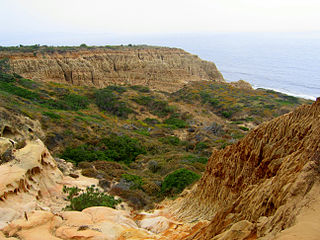
Torrey Pines State Natural Reserve is 2,000 acres of coastal state park located in the community of La Jolla, in San Diego, California, off North Torrey Pines Road. Although it is located within San Diego city limits, it remains one of the wildest stretches of land (8 km²) on the Southern California coast. It is bordered immediately on the south by Torrey Pines Municipal Golf Course and on the north by the city of Del Mar. The reserve was designated a National Natural Landmark in 1977.

Torrey Pines Golf Course is a 36-hole municipal golf facility on the west coast of the United States, owned by the city of San Diego, California. It sits on the coastal cliffs overlooking the Pacific Ocean in the community of La Jolla, just south of Torrey Pines State Reserve. Opened 64 years ago in 1957, it was built on the site of Camp Callan, a U.S. Army installation during World War II.

Christopher Whitelaw Pine is an American actor. Pine made his feature film debut as Lord Devereaux in The Princess Diaries 2: Royal Engagement (2004). He is best known for his roles as James T. Kirk in the Star Trek reboot film series (2009–2016), Will Colson in Unstoppable (2010), Cinderella's Prince in Into the Woods (2014), Jack Ryan in Jack Ryan: Shadow Recruit (2014), Toby Howard in Hell or High Water (2016), Bernie Webber in The Finest Hours (2016), Steve Trevor in Wonder Woman (2017) and Wonder Woman 1984 (2020), Dr. Alexander Murry in A Wrinkle in Time (2018), and Robert the Bruce in Outlaw King (2018).
The Pine Tar Incident was a controversial incident in 1983 during an American League baseball game played between the Kansas City Royals and New York Yankees at Yankee Stadium in New York City on July 24, 1983.


















